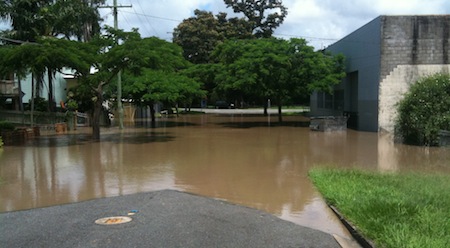Preparing for the flood – 12 January 2011
It’s been a huge few days since we first started to realise that it looked like Brisbane would be hit by another of the cyclical floods that happen every 30 to 40 years.
Brisbane is at the end of the Brisbane River, a long, slow moving, meandering brown waterway that drains much of the country from the Great Dividing Range to the west and into the north. As noted by John Oxley as the first explorer in 1823 when he sailed upstream to where Brisbane now sits, the river has no watershed to keep the flow constant but relies on rainfall from it’s catchment. This inevitability leads to periods of low flow where the river becomes a tidal stream washing upstream on the high tide and downstream on the low tide, much like we’ve had for the last 20 years of drought. He noted from the rotting vegetation high on Spring Hill and Kangaroo Point that this natural choke between these high points must cause massive floods during high rainfall.
John Oxley is basically correct and it seem that the cycle of this flood is based on the La Nina oceanic temperature phenomena where the water temperature warms causing greater precipitation, including cyclones which can impact on Brisbane as happened in the 1974 flood. This cycle has lead to minor and more occasional major floods in 1865, 1893, 1931, 1974 and now 2011.
I remember well, as a 14 year old in Toowoomba, watching the black and white television images of the massive destruction and flooding that was the Brisbane flood of 1974, wondering what it would be like to experience that event, and yes even wondering of how exciting it might be to be involved – Now I know.
On Monday the 10 January 2011 a slow moving trough had settled over the catchment of the Brisbane River dumping rain on the already soaked area that had seen an unusually high rainfall. The long ten year drought had well and truly broken and now the dams were fall and spilling, a vast change from when there was but 25% in them just a few years ago. How good was it to now not to be on water restrictions and able to use water freely but this was getting ridiculous now, with rain soaked ground causing each new drop to run off filling the flood mitigation percentages of the dams and swelling the streams.
Then the unthinkable happened, something that no one has ever heard or seen before. My home town of Toowoomba high on the range at 340m above sea level, sat in a place where the dense moist air rose, chilled and dumped it’s contents on the escarpment and on Toowoomba itself. It was as if God had emptied a bucket on the town, filling the creeks, flash flooding the shops, sweeping away everything in it’s path including cars, shipping containers and people. Sadly two people died when they were trapped in their vehicles by this surging wall of water. This is what they had to deal with in the Toowoomba Flood
Then it got worse…
The water that was dumped on Toowoomba flows west to the Darling Downs causing flooding in many smaller towns, some for the second time in a fortnight but what happened to the east was of biblical proportions of horror. Continue reading

